A Validation Study for RANS Based Modelling of Swirling Pulverized Fuel Flames
Abstract
:1. Introduction
2. Modelling
2.1. Two-Phase Flow Modelling
2.1.1. Eulerian Description of the Gas Phase
2.1.2. Lagrangian Description of the Particle Phase
2.2. Turbulence Modelling for the Gas Phase
2.2.1. Turbulent Viscosity Models
2.2.2. Differential Reynolds Stress Model (RSM)
2.3. Turbulence Modelling for the Particle Phase
2.4. Radiation Modelling
2.5. Combustion Modelling
2.5.1. Pyrolysis
2.5.2. Char Oxidation
2.5.3. Gas Phase Reactions
3. Test Case and Fuel Specific Definitions and Modelling
Discrete Representation of the Particle Phase
4. Solution Domain, Boundary Conditions
5. Grid Generation
6. Predictions, Comparisons with Measurements
6.1. Field Distributions
6.2. Line Plots
7. Investigations on the Resolution of the Particle Phase
7.1. Turbulent Particle Dispersion
7.2. Resolution of the Particle Size Distribution
7.2.1. Representation by the Rosin-Rammler Distribution Function
7.2.2. Resolution of the Particle Size Distribution
8. Conclusions
Author Contributions
Funding
Institutional Review Board Statement
Informed Consent Statement
Data Availability Statement
Acknowledgments
Conflicts of Interest
Nomenclature
| AP | Particle surface area (m2) |
| CD | Drag coefficient (-) |
| cP | Particle specific heat capacity (J kg−1 K−1) |
| D | Outer diameter of secondary air nozzle (m) |
| d | Particle diameter (m, μm) |
| dS | Sieve mesh size (μm) |
| d0.632 | Characteristic particle size in RR distribution |
| G | Incident radiation (W m2) |
| h | Specific standardized enthalpy (J kg−1) |
| Reynolds flux vector of variable φ (corresponding units) | |
| k | Turbulence kinetic energy (m2 s−2) |
| ki | Rate coefficient of reaction i (s−1) |
| L | Furnace length (m) |
| M | Number of particle random walks (trials) |
| mP | Particle mass (kg) |
| N | Number of particle size classes |
| Nu | Nusselt number (-) |
| n | Parameter in RR |
| Pr | Prandtl number (-) |
| p | Pressure (Pa) |
| Q | Rosin–Rammler distribution function (-) |
| R | Furnace radius (m) |
| ReP | Particle relative Reynolds number (-) |
| Ret | Reynolds number of turbulence (-) |
| r | Radial coordinate (m) |
| Sc | Schmidt number (-) |
| T | Static gas temperature (K) |
| TP | Particle temperature (K) |
| t | Time (s) |
| tr | Particle relaxation time (s) |
| u | Axial velocity (m s−1) |
| ui | Gas velocity vector (m s−1) |
| ui,P | Particle velocity vector (m s−1) |
| V | Velocity magnitude (m s−1) |
| w | Swirl velocity (m s−1) |
| x | Axial coordinate (m) |
| xi | Cartesian coordinates (m) |
| Yi | Mass fraction of species i |
| Greek Symbols | |
| δij | Kronecker delta |
| Δm | Mass fraction in a particle size class |
| ε | Dissipation rate of k (m2 s−3) |
| εP | Particle emissivity (-) |
| λ | Thermal conductivity (W m−1 K−1) |
| μ | Viscosity (Pa s) |
| μt | Turbulent viscosity (Pa s) |
| ρ | Gas density (kg m−3) |
| ρP | Particle density (kg m−3) |
| Reynolds stress tensor (Pa) | |
| σ | Stefan–Bolzmann constant 5.6704·10−8 (W m2 K4) |
| χ | Percentage deviation (-) |
| ω | Specific dissipation rate of k (s−1) |
| Sub- and Superscripts | |
| P | Particle |
| t | Turbulent |
| VW | Volatile matter |
| W | Water |
| 0 | Initial value |
| Abbreviations | |
| AR | As Received |
| CFD | Computational Fluid Dynamics |
| DAF | Dry Ash Free |
| HHV | Higher Heating Value |
| IRZ | Internal Recirculation Zone |
| LES | Large Eddy Simulation |
| LHV | Lower Heating Value |
| R-KE | Realizable k-ε Model |
| RANS | Reynolds Averaged Numerical Simulation |
| RNG | Renormalization Group Theory |
| RNG-KE | RNG k-ε model |
| RR | Rosin–Rammler distribution function |
| RSM | Reynolds Stress Model |
| RWTH | Rheinisch-Westfälische Technische Hochschule |
| S-KE | Standard k-ε model |
| SC | Particle Size Class |
| SD | Particle Size Distribution |
| SMD | Sauter Mean Diameter |
| SST | Shear Stress Transport k-ω model |
| TPD | Turbulent Particle Dispersion |
| TV | Turbulent Viscosity |
References
- Lackner, M.; Winter, F.; Agarwal, A.K. (Eds.) Handbook of Combustion; Wiley: Chichester, UK, 2010. [Google Scholar]
- Benim, A.C.; Diederich, M.; Gül, F.; Oclon, P.; Taler, J. Computational and experimental investigation of the aerodynamics and aeroacoustics of a small wind turbine with quasi-3D optimization. Energy Convers. Manag. 2018, 177, 143–149. [Google Scholar] [CrossRef]
- Bhattacharyya, S.; Chattopadhyay, H.; Benim, A.C. Heat transfer enhancement of laminar flow of ethylene glycol through a square channel fitted with angular cut wavy strip. Procedia Eng. 2016, 157, 19–28. [Google Scholar] [CrossRef] [Green Version]
- Bhattacharyya, S.; Benim, A.C.; Chattopadhyay, H.; Banerjee, A. Experimental investigation of heat transfer performance of corrugated tube with spring tape inserts. Exp. Heat Transf. 2019, 32, 411–425. [Google Scholar] [CrossRef]
- Tahat, M.S.; Benim, A.C. Experimental analysis on thermophysical properties of Al2O3/CuO hybrid nano fluid with its effects on flat plate solar collector. Defect Diffus. Forum 2017, 374, 148–156. [Google Scholar] [CrossRef]
- Benim, A.C.; Pfeiffelmann, B.; Oclon, P.; Taler, J. Computational investigation of a lifted hydrogen flame with LES and FGM. Energy 2019, 173, 1172–1181. [Google Scholar] [CrossRef]
- Jaseliunaite, J.; Povilaitis, M.; Stucinskaite, I. RANS- and TFC-based simulation of turbulent combustion in a small-scale venting chamber. Energies 2021, 14, 5710. [Google Scholar] [CrossRef]
- Pfeiffelmann, B.; Diederich, M.; Gül, F.; Benim, A.C.; Heese, M.; Hamberger, A. Computational and experimental investigation of an industrial biomass furnace. Chem. Eng. Technol. 2021, 44, 1538–1546. [Google Scholar] [CrossRef]
- Rosendahl, L. (Ed.) Biomass Combustion Science, Technology and Engineering; Elsevier: Amsterdam, The Netherlands, 2013. [Google Scholar]
- Knaus, H.; Schnell, U.; Hein, R.G.K. On the modelling of coal combustion in a 550 MWel coal-fired utility boiler. Prog. Comput. Fluid Dyn. Int. J. 2001, 1, 194–207. [Google Scholar] [CrossRef]
- Schnell, U. Numerical modelling of solid fuel combustion processes using advanced CFD-based simulation tools. Prog. Comput. Fluid Dyn. Int. J. 2001, 3, 208–218. [Google Scholar] [CrossRef]
- Ruckert, F.U.; Sabel, T.; Schnell, U.; Hein, K.R.G.; Risio, B. Comparison of different global reaction mechanisms for coal-fired utility boilers. Prog. Comput. Fluid Dyn. Int. J. 2003, 3, 130–139. [Google Scholar] [CrossRef]
- Kurose, R.; Makino, H.; Suzuki, A. Numerical analysis of pulverized coal combustion characteristics using advanced low-NOx burner. Fuel 2004, 83, 693–703. [Google Scholar] [CrossRef]
- Kurose, R.; Makino, H.; Suzuki, A. Pulverized coal combustion characteristics of high-fuel-ratio coals. Fuel 2004, 83, 1777–1785. [Google Scholar] [CrossRef]
- Stein, O.T.; Kempf, A.M.; Ma, T.; Olbricht, C. Large eddy simulation of non-reacting flow in a 40 MW pulverised coal combustor. Prog. Comput. Fluid Dyn. Int. J. 2011, 11, 397–402. [Google Scholar] [CrossRef]
- Alexander, S.; Alobaid, F.; Jan-Peter, B.; Ströhle, J.; Epple, B. 3-D numerical simulation of co-firing of torrefied biomass in a pulverized-fired 1 MWth combustion chamber. Energy 2015, 85, 105–116. [Google Scholar] [CrossRef]
- Sharma, R.; May, J.; Alobaid, F.; Ohlemüller, P.; Ströhle, J.; Epple, B. Euler-Euler CFD simulation of the fuel reactor of a 1 MWth chemical-loopng pilot plant: Influence of drag models and specularity coefficient. Fuel 2017, 200, 435–446. [Google Scholar] [CrossRef]
- Appadurai, A.; Raghavan, V. Choice of model parameters in turbulent gas-solid flow simulations of particle classifiers. Prog. Comput. Fluid Dyn. Int. J. 2019, 19, 235–249. [Google Scholar] [CrossRef]
- Wen, X.; Fan, J. Flamelet modelling of laminar pulverized coal combustion with different particle sizes. Adv. Powder Technol. 2019, 30, 2964–2979. [Google Scholar] [CrossRef]
- Wen, X.; Rieth, M.; Scholtissek, A.; Stein, O.T.; Wang, H.; Luo, K.; Kempf, A.M.; Kronenburg, A.; Fan, J.; Hasse, C. A comprehensive study of flamelet tabulation methods for pulverized coal combustion in a turbulent mixing layer—Part I: A priori and budget analyses. Combust. Flame 2020, 216, 439–452. [Google Scholar] [CrossRef]
- Wen, X.; Rieth, M.; Scholtissek, A.; Stein, O.T.; Wang, H.; Luo, K.; Kempf, A.M.; Kronenburg, A.; Fan, J.; Hasse, C. A comprehensive study of flamelet tabulation methods for pulverized coal combustion in a turbulent mixing layer—Part II: Strong heat losses and multi-mode combustion. Combust. Flame 2020, 216, 453–467. [Google Scholar] [CrossRef]
- Meller, D.; Lipkowicz, T.; Rieth, M.; Stein, O.T.; Kronenburg, A.; Hasse, C.; Kempf, A.M. Numerical analysis if a turbulent pulverized coal flame using a flamelet/progress variable approach and modeling experimental artifacts. Energy Fuels 2021, 35, 7133–7143. [Google Scholar] [CrossRef]
- Epple, B.; Leithner, R.; Linzer, W.; Walter, H. (Eds.) Simulation von Kraftwerken und Feuerungen; Springer: Berlin, Germany, 2012. [Google Scholar]
- Hasse, C.; Debiagi, P.; Wen, X.; Hildebrand, K.; Vascellari, M.; Faravelli, T. Advanced modelling approaches for CFD simulations of coal combustion and gasification. Prog. Energy Combust. Sci. 2021, 86, 100938. [Google Scholar] [CrossRef]
- Toporov, D.; Bocian, P.; Heil, P.; Kellermann, A.; Stadler, H.; Tschunko, S.; Förster, M.; Kneer, R. Detailed investigation of a pulverized fuel swirl flame in CO2/O2 atmosphere. Combust. Flame 2008, 155, 605–618. [Google Scholar] [CrossRef]
- Chen, L.; Ghoniem, A.F. Simulation of oxy-coal combustion in a 100 kWth test facility using RANS and LES: A validation study. Energy Fuels 2012, 26, 4783–4798. [Google Scholar] [CrossRef]
- Francetti, B.M.; Marincola, F.C.; Navarro-Martinez, S.; Kempf, A.M. Large eddy simulation of a 100 kWth swirling oxy-coal furnace. Fuel 2016, 181, 491–502. [Google Scholar] [CrossRef] [Green Version]
- Sadiki, A.; Agrebi, S.; Chrigui, M.; Doost, A.S.; Knappstein, R.; Di Mare, F.; Janicka, J.; Massmeyer, A.; Zabrodiec, D.; Hees, J.; et al. Analyzing the effects of turbulence and multiphase treatment on oxy-coal combustion process predictions using LES and RANS. Chem. Eng. Sci. 2017, 166, 283–302. [Google Scholar] [CrossRef]
- Gaikwad, P.; Kulkarni, H.; Sreedhara, S. Simplified numerical modelling of oxy-fuel combustion of pulverized coal in a swirl burner. Appl. Therm. Eng. 2017, 124, 734–745. [Google Scholar] [CrossRef]
- Nicolai, H.; Wen, X.; Miranda, F.C.; Zabrodiec, D.; Massmeyer, A.; Di Mare, F.; Dreizler, A.; Hasse, C.; Kneer, R.; Janicka, J. Numerical investigation of swirl-stabilized pulverized coal flames in air and oxy-atmospheres by means of large eddy simulation coupled with tabulated chemistry. Fuel 2021, 287, 119429. [Google Scholar] [CrossRef]
- Wen, X.; Nicolai, H.; Schneider, H.; Cai, L.; Janicka, J.; Pitsch, H.; Hasse, C. Flamelet LES of a swirl-stabilized multi-stream pulverized coal burner in air and oxy-fuel atmospheres with pollutant formation. Proc. Combust. Inst. 2021, 38, 4141–4149. [Google Scholar] [CrossRef]
- Pope, S.B. Turbulent Flows; Cambridge University Press: Cambridge, UK, 2020. [Google Scholar]
- Benim, A.C. Finite element analysis of confined turbulent swirling flows. Int. J. Numer. Methods Fluids 1990, 11, 697–717. [Google Scholar] [CrossRef]
- ANSYS Fluent Theory Guide. In Release 2018; ANSYS Inc.: Canonsburg, PA, USA, 2018.
- Moukalled, F.; Mangani, L.; Darwisch, M. The Finite Volume Method in Computational Fluid Dynamics; Springer: Berlin, Germany, 2016. [Google Scholar]
- Van Doormaal, J.P.; Raithby, G.D. Enhancements of the SIMPLE method for predicting incompressible fluid flows. Numer. Heat Transf. 1984, 7, 147–163. [Google Scholar] [CrossRef]
- Leonard, B.P. A stable and accurate convective modelling procedure based on quadratic upstream interpolation. Comput. Methods Appl. Mech. Eng. 1979, 19, 59–98. [Google Scholar] [CrossRef]
- Patankar, S. Numerical Heat Transfer and Fluid Flow; CRC Press: Boca Raton, FL, USA, 2009. [Google Scholar]
- Durbin, P.A.; Reif, B.A.P. Statistical Theory and Modeling for Turbulent Flows, 2nd ed.; Wiley: Chichester, UK, 2011. [Google Scholar]
- Turns, S.R. An Introduction to Combustion, 3rd ed.; McGraw-Hill: New York, NY, USA, 2012. [Google Scholar]
- Benim, A.C.; Epple, B.; Krohmer, B. Modelling of pulverised coal combustion by a Eulerian-Eulerian two-phase flow formulation. Prog. Comput. Fluid Dyn. Int. J. 2005, 5, 345–361. [Google Scholar] [CrossRef]
- Durst, F.; Miloievic, D.; Schönung, B. Eulerian and Lagrangian predictions of particulate two-phase flows: A numerical study. Appl. Math. Model. 1984, 8, 101–115. [Google Scholar] [CrossRef]
- Schiller, L.; Naumann, A. Über die grundlegenden Berechnungen bei der Schwerkraftaufbereitung. Z. Ver. Dtsch. Inge. 1933, 77, 318–320. [Google Scholar]
- Ranz, W.E.; Marshall, W.R., Jr. Evaporation from drops, Part I. Chem. Eng. Prog. 1952, 48, 141–146. [Google Scholar]
- Ranz, W.E.; Marshall, W.R., Jr. Evaporation from drops, Part II. Chem. Eng. Prog. 1952, 48, 173–180. [Google Scholar]
- Launder, B.E.; Spalding, D.B. The numerical computation of turbulent flows. Comput. Methods Appl. Mech. Eng. 1974, 3, 269–289. [Google Scholar] [CrossRef]
- Shih, T.-H.; Liou, W.W.; Shabbir, A.; Yang, Z.; Zhu, J. A new k-ε eddy-viscosity model for high Reynolds number turbulent flows-model development and validation. Comput. Fluids 1995, 24, 227–238. [Google Scholar] [CrossRef]
- Yakhot, V.; Orszag, S.A. Renormalization group analysis of turbulence: I. Basic theory. J. Sci. Comput. 1986, 1, 3–51. [Google Scholar] [CrossRef]
- Menter, F.R. Two-equation eddy-viscosity turbulence models for engineering applications. AIAA J. 1994, 32, 1598–1605. [Google Scholar] [CrossRef] [Green Version]
- Speziale, C.G.; Sarkar, S.; Gatski, T.B. Modelling the pressure-strain correlation of turbulence: An invariant dynamical systems approach. J. Fluid Mech. 1991, 227, 245–272. [Google Scholar] [CrossRef]
- Gosman, A.C.; Ioannides, E. Aspects of computer simulation of liquid-fuelled combustors. J. Energy 1983, 7, 482–490. [Google Scholar] [CrossRef]
- Özisik, M.N. Radiative Transfer; Wiley: Chichester, UK, 1973. [Google Scholar]
- Smith, T.F.; Shen, Z.F.; Friedman, J.N. Evaluation of coefficients for the weighted sum of gray gases model. J. Heat Transf. 1982, 104, 602–608. [Google Scholar] [CrossRef]
- Badzioch, S.; Hawskley, P.G.W. Kinetics of thermal decomposition of pulverized coal particles. Ind. Eng. Chem. Process. Des. Dev. 1970, 9, 521–530. [Google Scholar] [CrossRef]
- Field, M.A.; Gill, D.W.; Morgan, B.B.; Hawskley, P.G.W. Combustion of Pulverized Coal; The British Coal Utilization Research Association: Glocuestershire, UK, 1967. [Google Scholar]
- Baum, M.M.; Street, P.J. Predicting the combustion behavior of coal particles. Combust. Sci. Technol. 1971, 3, 231–243. [Google Scholar] [CrossRef]
- Smoot, L.D.; Pratt, D.T. (Eds.) Pulverized Coal Combustion and Gasification; Plenum Press: New York, NY, USA, 1979. [Google Scholar]
- Magnussen, B.F.; Hjertager, B.H. On mathematical modelling of turbulent combustion with special emphasis on soot formation and combustion. Symp. (Int.) Combust. 1977, 16, 719–729. [Google Scholar] [CrossRef]
- Dryer, F.L.; Glassmann, L. High temperature oxidation of CO and CH4. Symp. (Int.) Combust. 1973, 14, 987–1003. [Google Scholar] [CrossRef]
- Westbrook, C.K.; Dryer, F.L. Simplified reaction mechanisms for the oxidation of hydrocarbon fuels in flames. Combust. Sci. Technol. 1981, 27, 31–43. [Google Scholar] [CrossRef]
- Zabrodiec, D.; Becker, L.; Hees, J.; Maßmeyer, A.; Habermehl, M.; Hatzfeld, O.; Dreizler, A.; Kneer, R. Detailed analysis of the velocity fields from 60 kW swirl-stabilized coal flames in CO2/O2 and N2/O2 atmospheres by means of laser Doppler velocimetry and particle image velocimetry. Combust. Sci. Technol. 2017, 10, 1751–1775. [Google Scholar] [CrossRef]
- Hees, J.; Zabrodiec, D.; Massmeyer, A.; Pielstricker, S.; Gövert, B.; Habermehl, M.; Hatzfeld, O.; Kneer, R. Detailed analyses of pulverized coal swirl flames in oxy-fuel atmospheres. Combust. Flame 2016, 172, 289–301. [Google Scholar] [CrossRef]
- Escudier, M.P.; Keller, J.J. Recirculation in swirling flow: A manifestation of vortex breakdown. AIAA J. 1985, 23, 111–116. [Google Scholar] [CrossRef]
- Xia, J.L.; Smith, B.L.; Benim, A.C.; Schmidli, J.; Yadigaroglu, G. Effect of inlet and outlet boundary conditions on swirling flows. Comput. Fluids 1997, 26, 811–823. [Google Scholar] [CrossRef]
- Dong, M.; Li, S.; Xie, J.; Han, J. Experimental studies on the normal impact of fly ash particles with planar surfaces. Energies 2013, 6, 3245–3262. [Google Scholar] [CrossRef]
- Lefebvre, A.H.; McDonnel, V.G. Atomization and Sprays, 2nd ed.; CRC Press: Boca Raton, FL, USA, 2017. [Google Scholar]
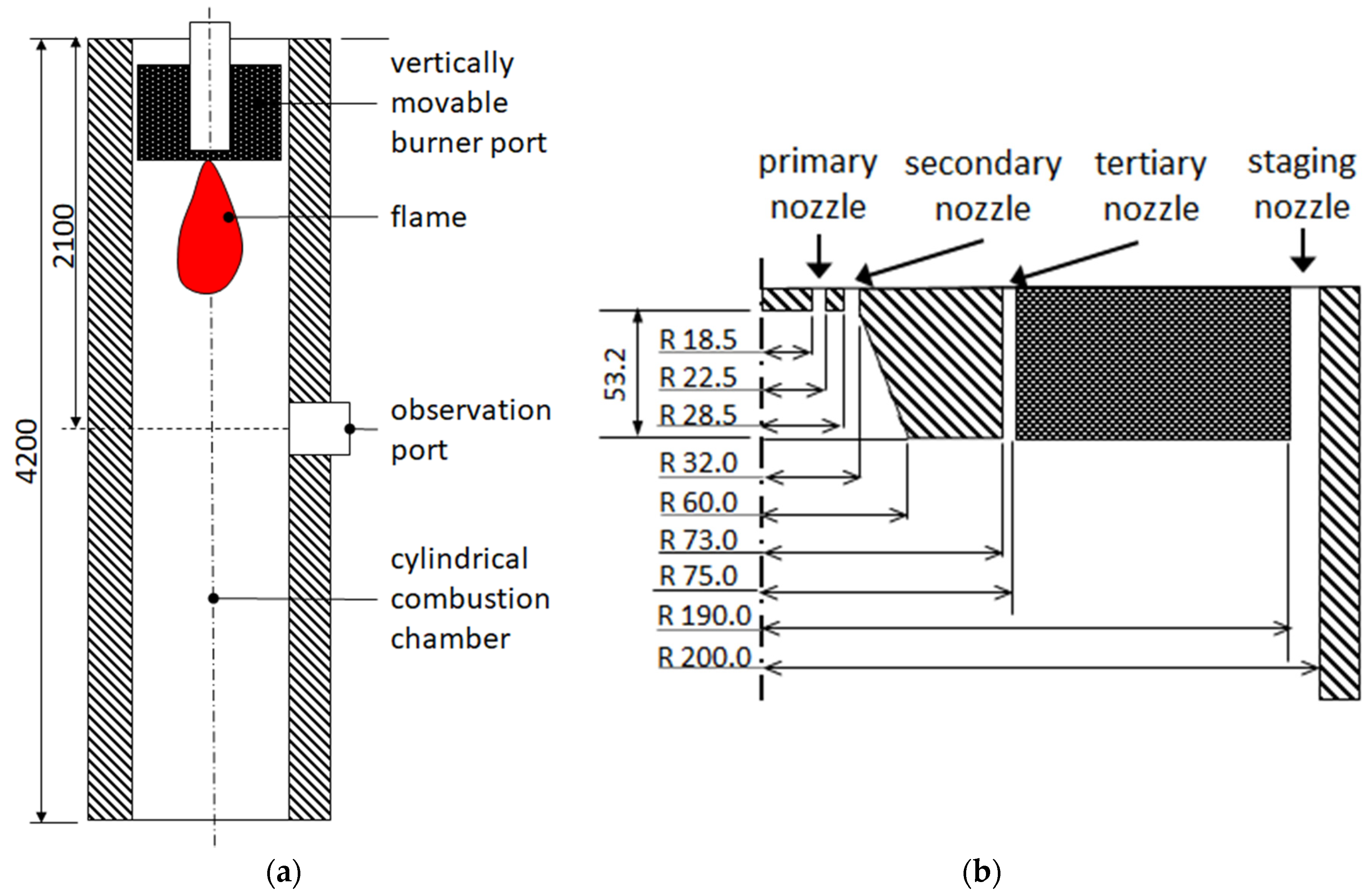

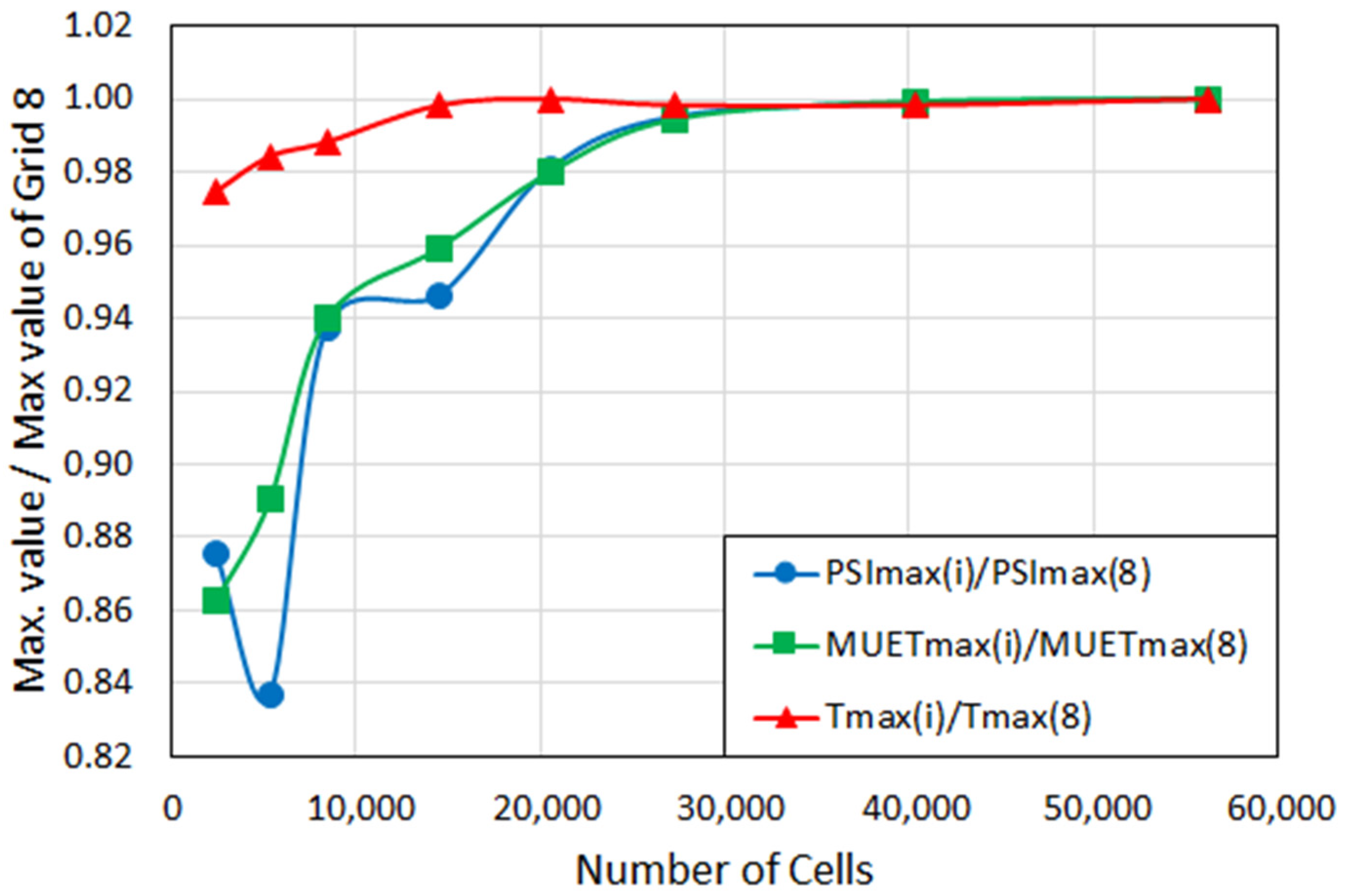


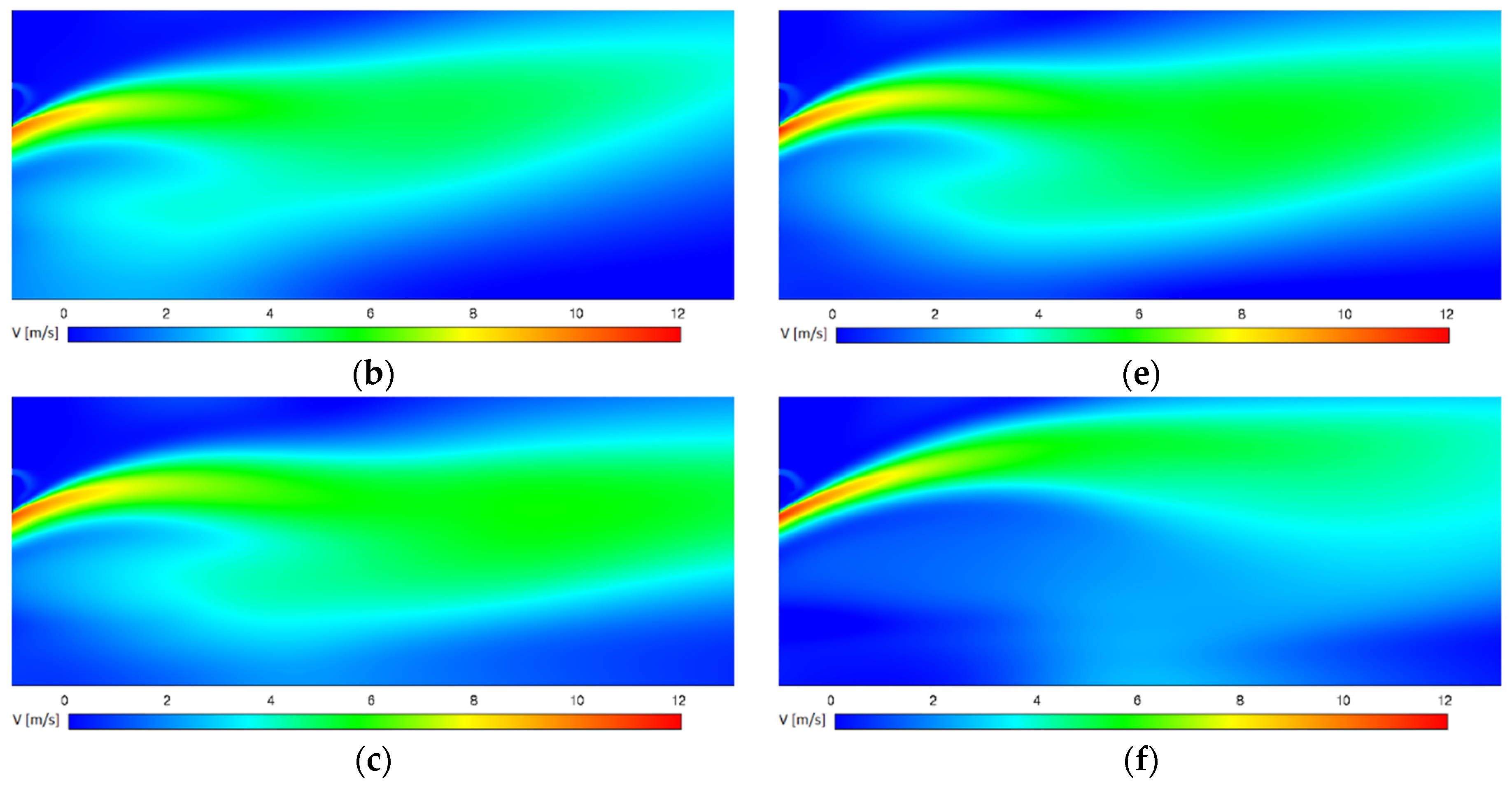
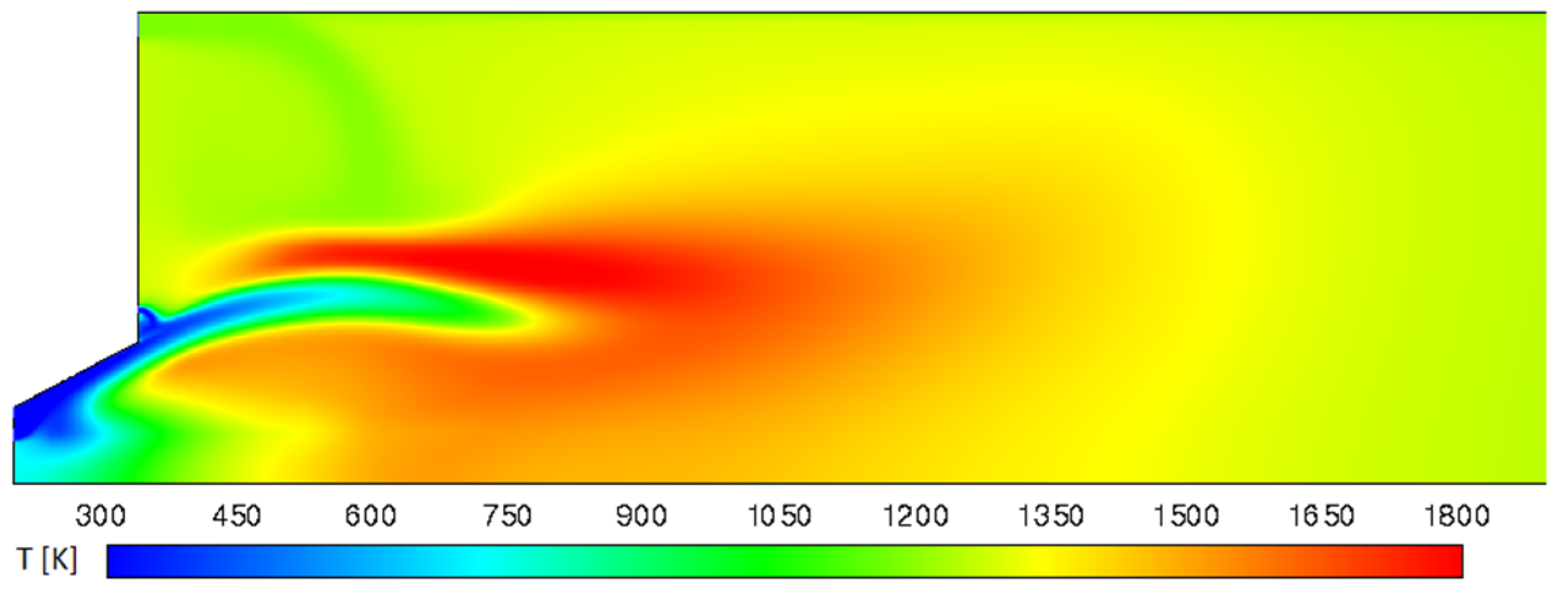
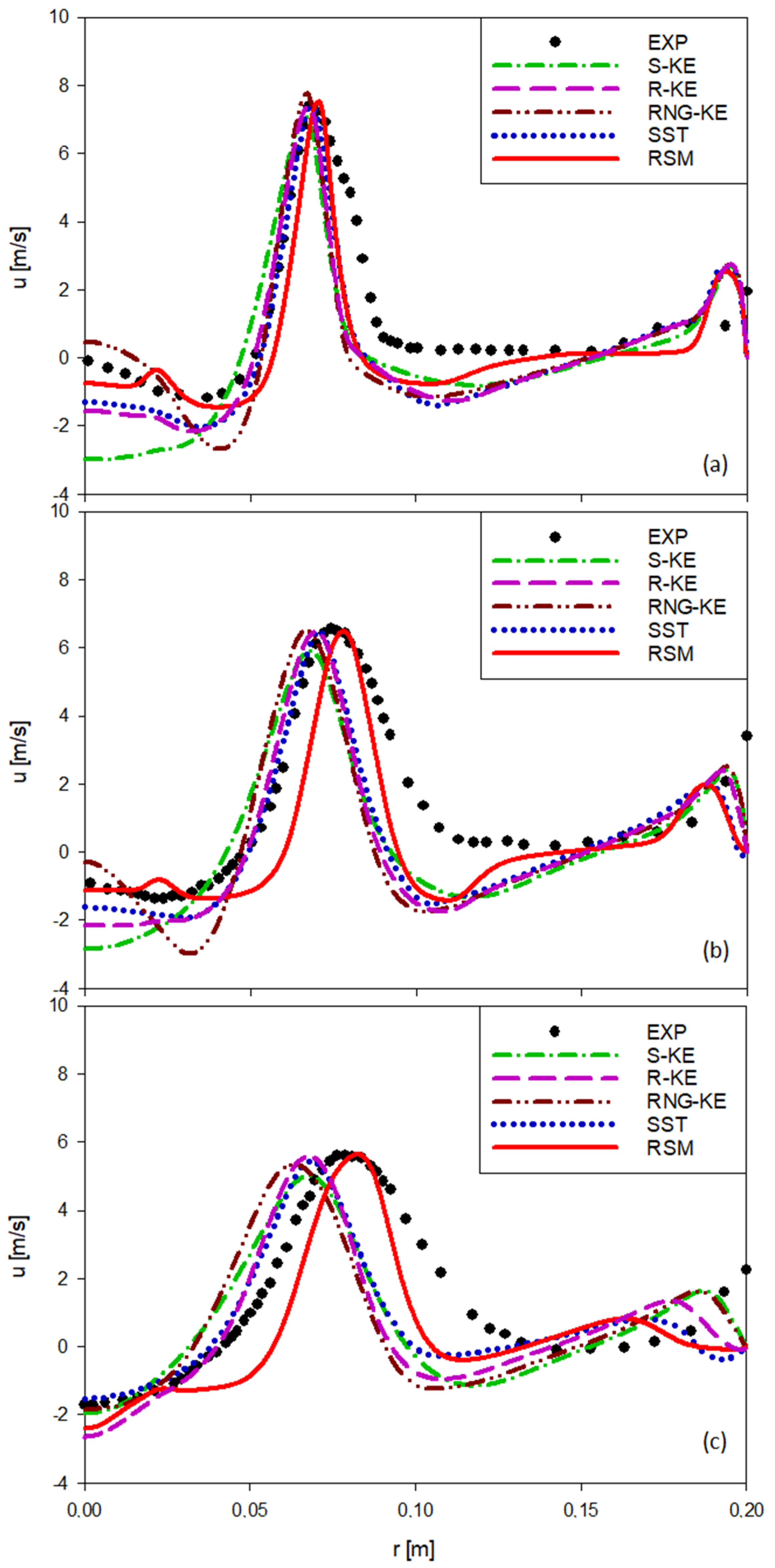
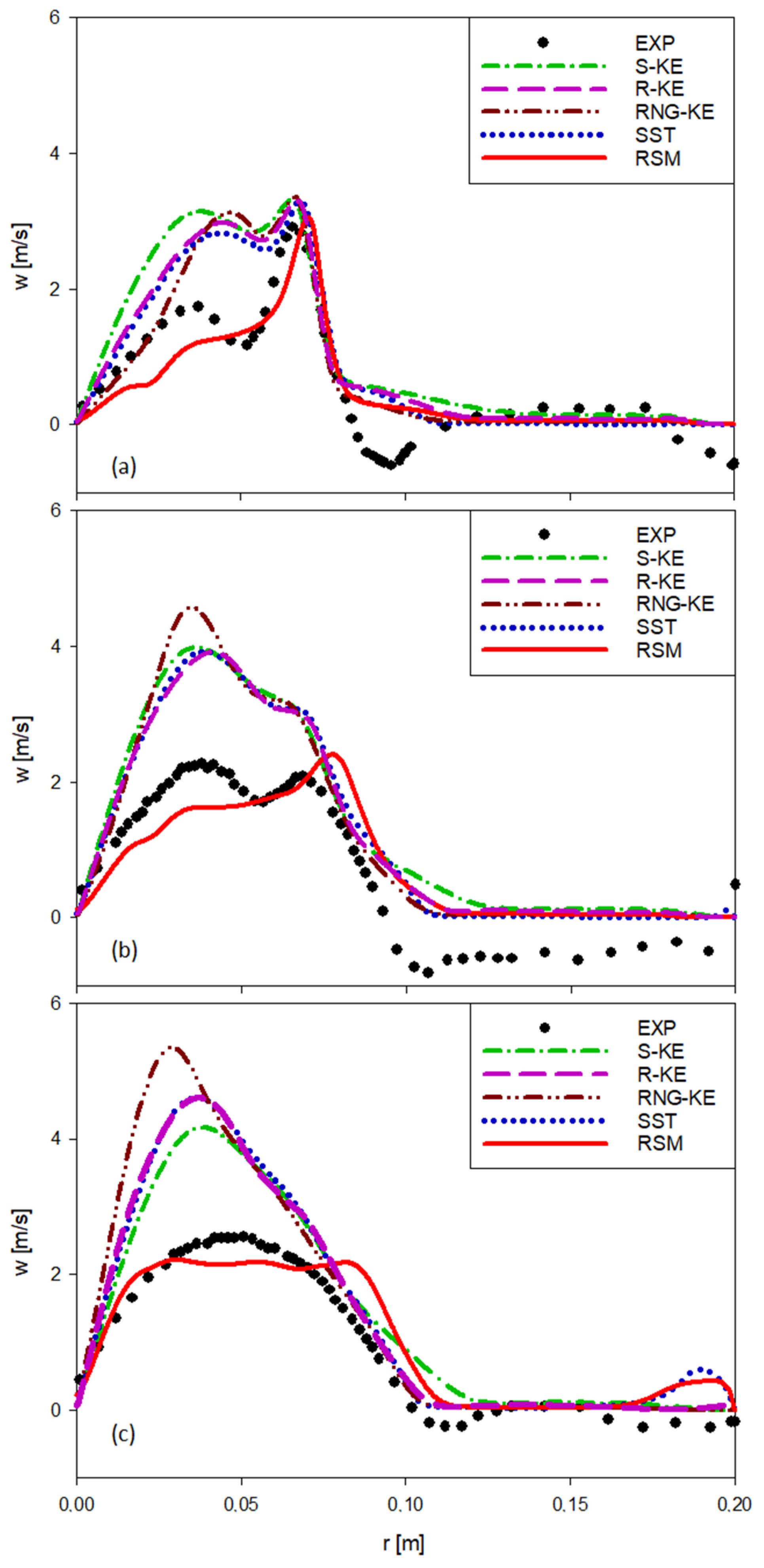
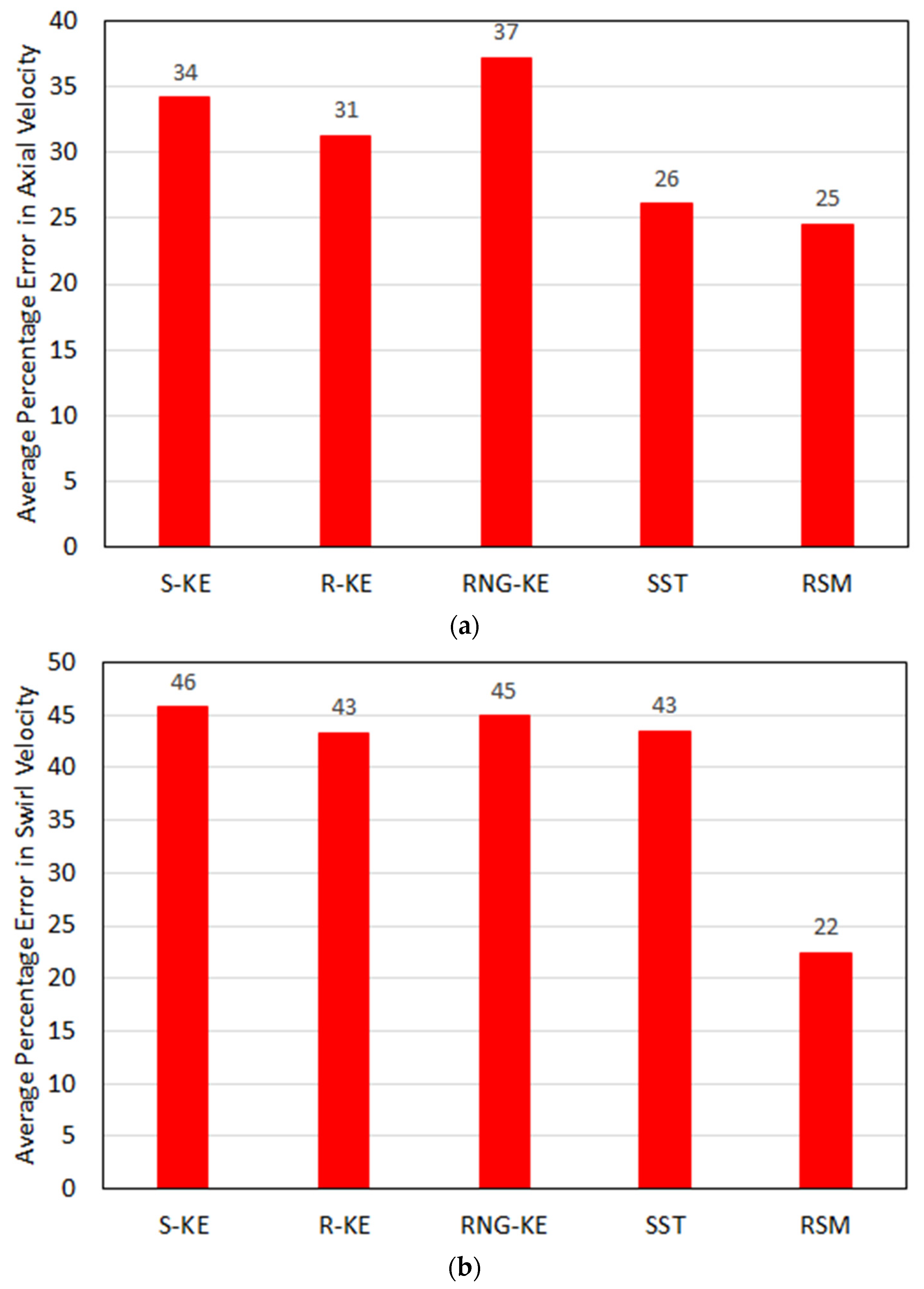
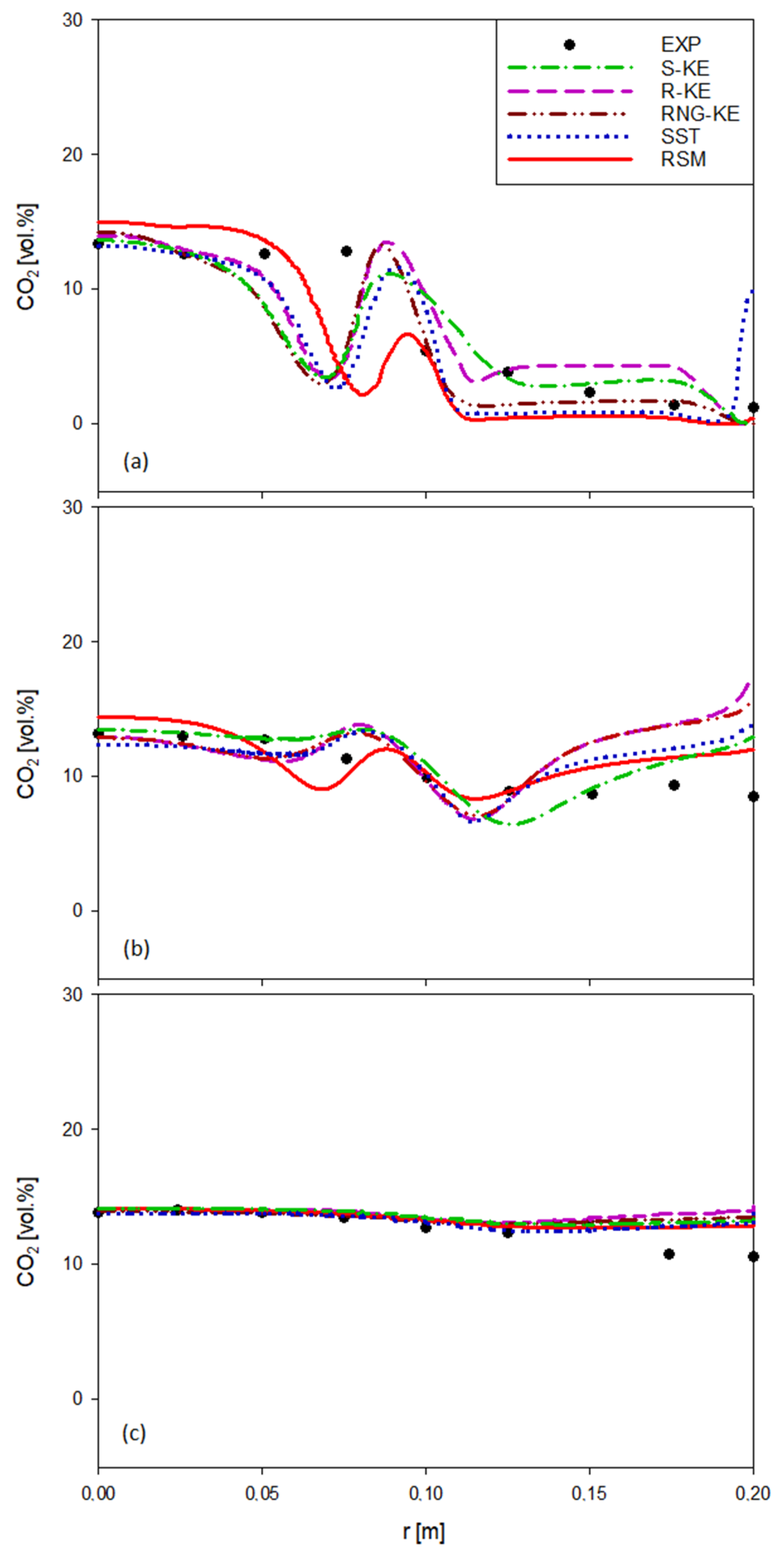



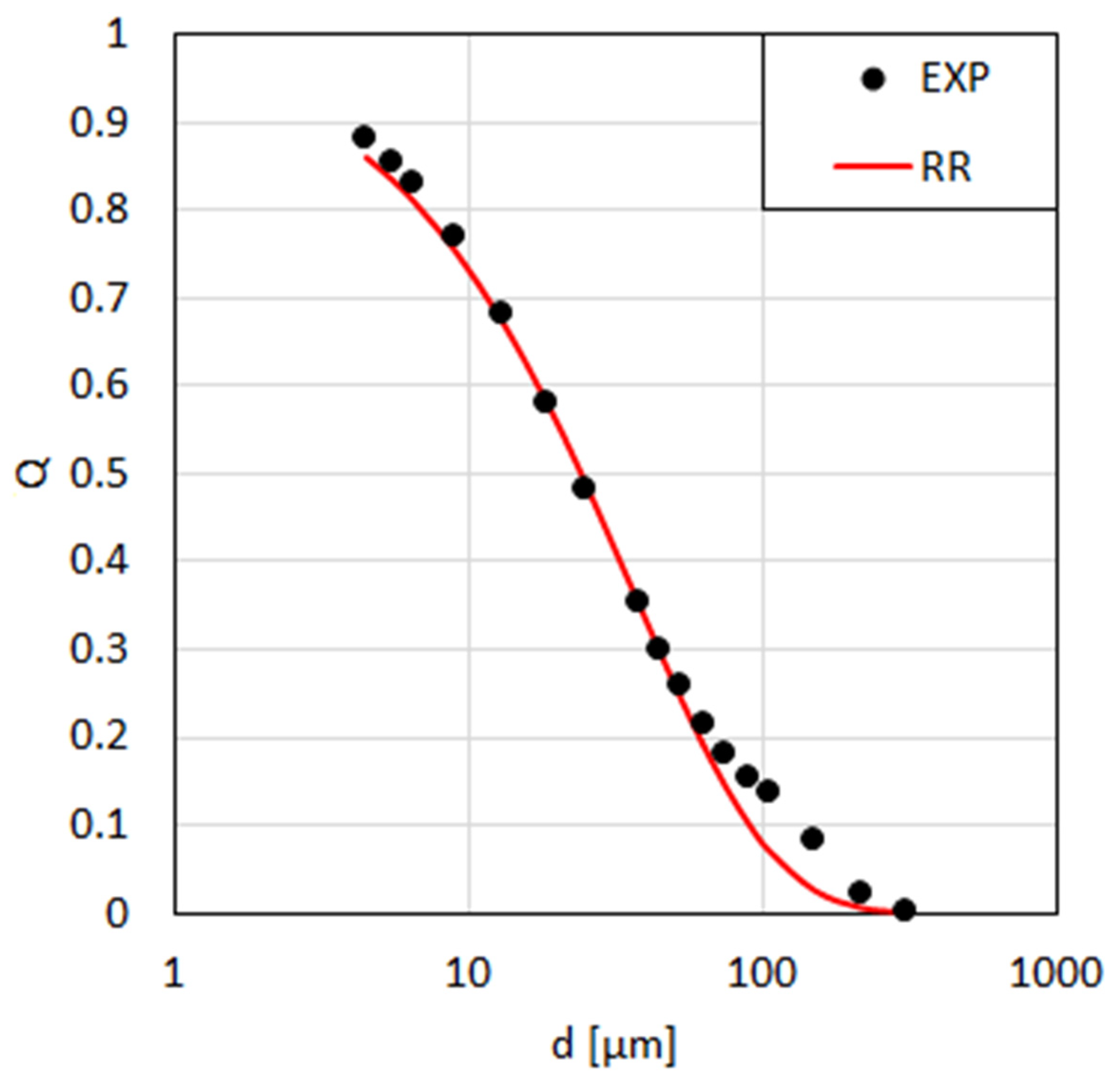
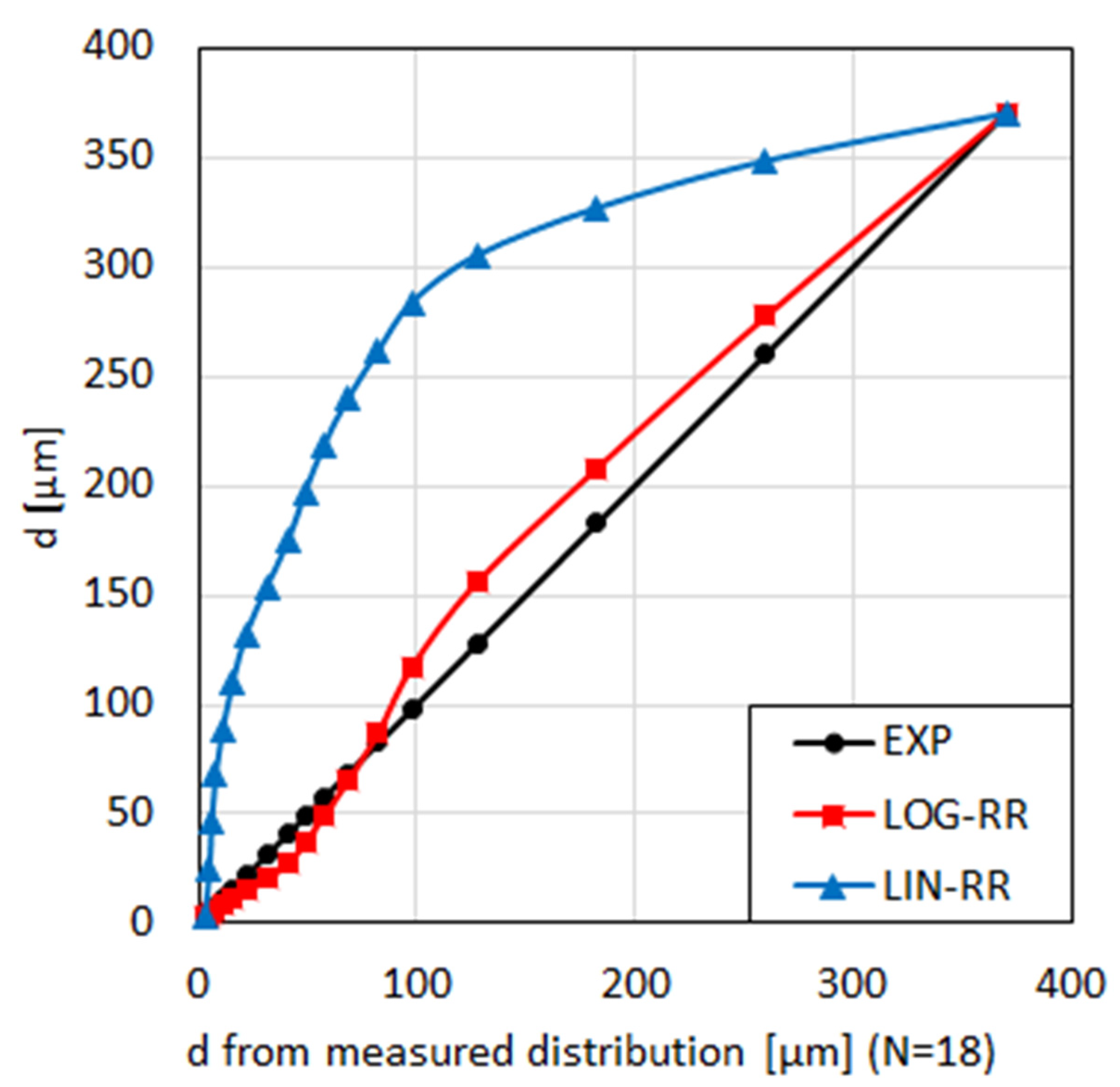

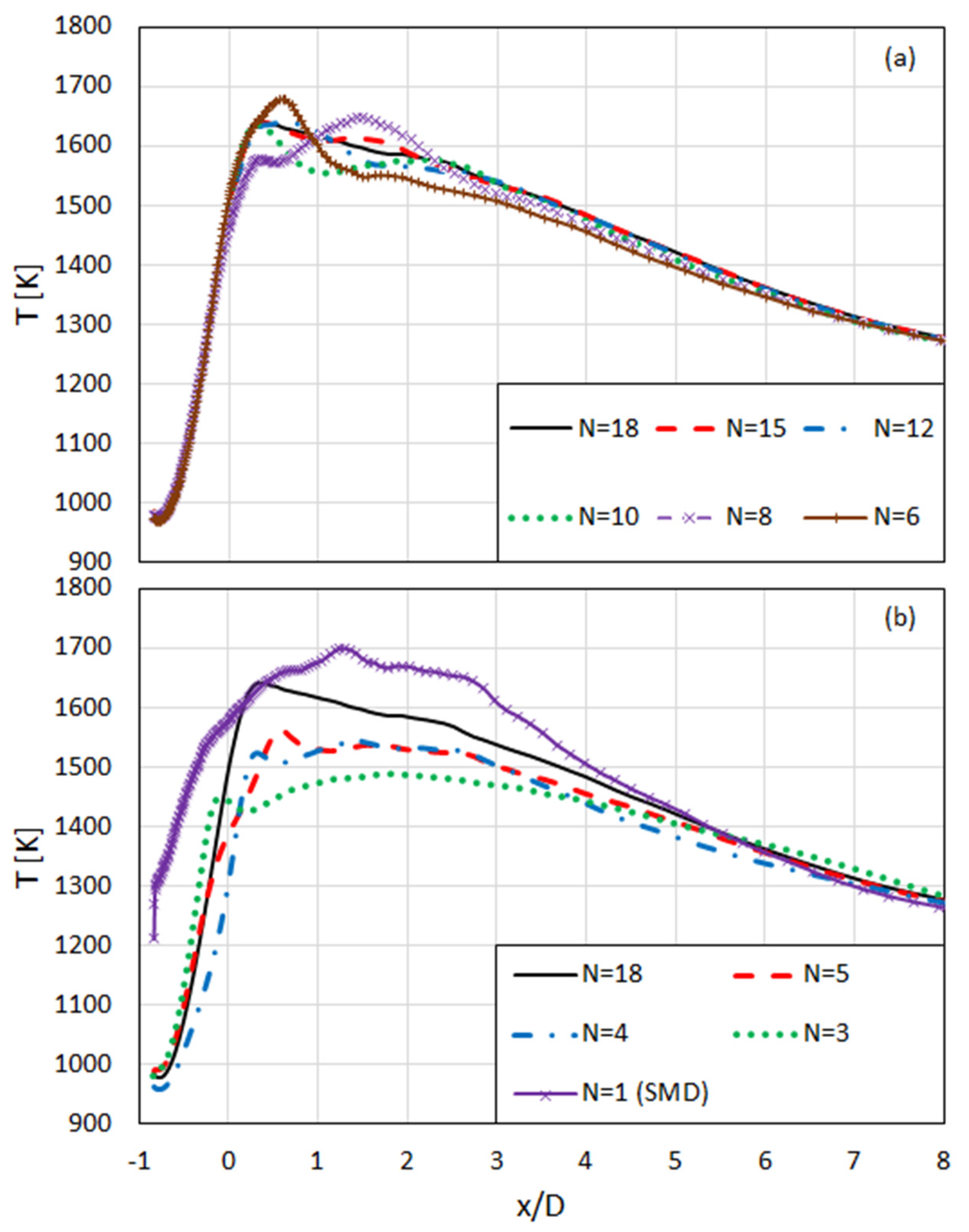
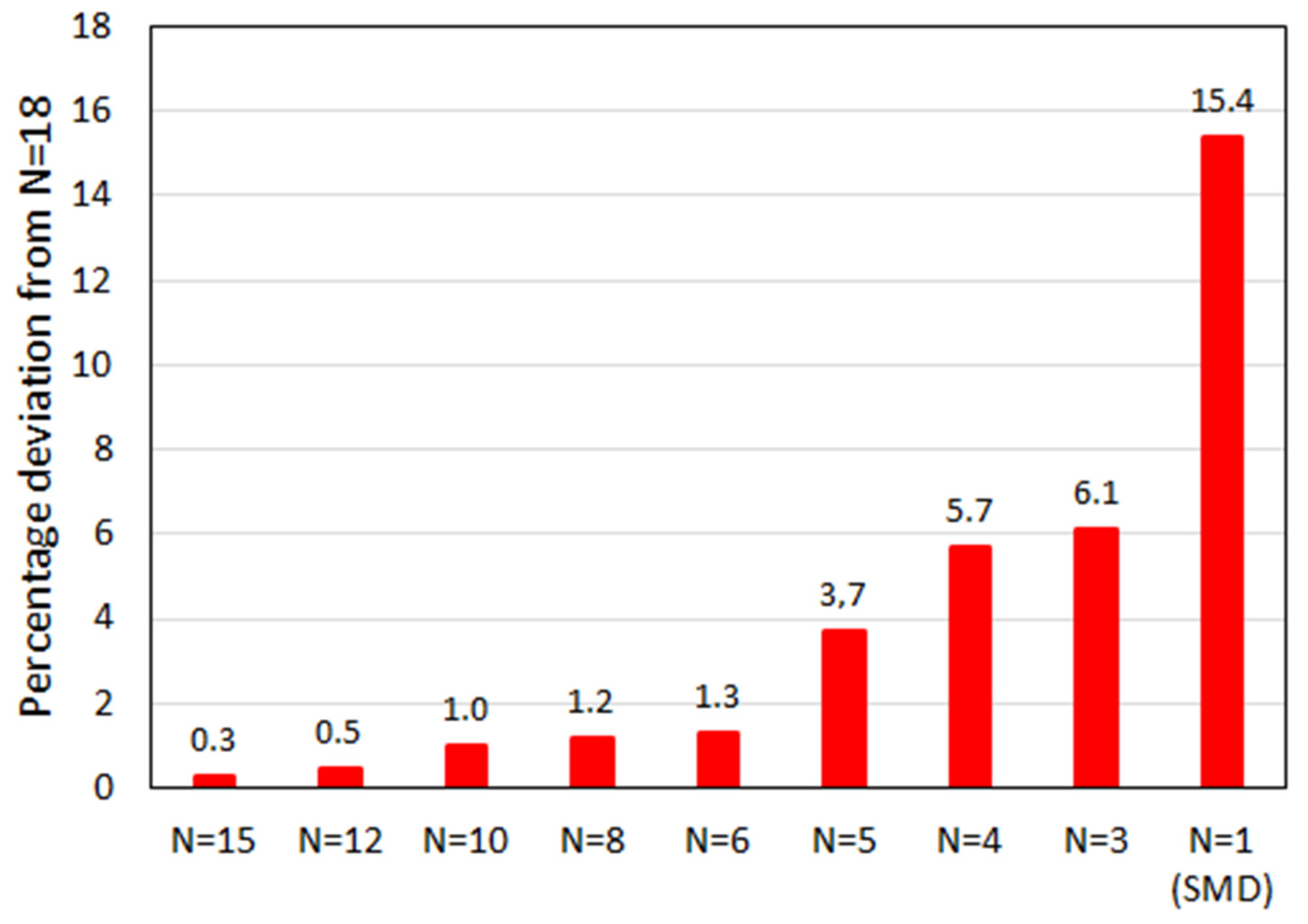
| S-KE | RNG-KE | R-KE | SST | |
|---|---|---|---|---|
| Cμ | 0.09 | 0.0845 | Fμ1 (S,Ωij) * | Fμ2 (ω, S, k, μ, y) * |
| S-KE | RNG-KE | R-KE | SST | |
|---|---|---|---|---|
| σk | 1.0 | 0.718 | 1.0 | varies between * 1.0–2.0 |
| Fk | 1.0 | 1.0 | 1.0 | varies between * 0.075–0.0828 |
| σε or σω | F1 | F2, F3 | |
|---|---|---|---|
| S-KE | 1.3 | 1.92 | |
| RNG-KE | 0.718 | ||
| R-KE | 1.2 | ||
| SST | varies between * 2.0–1.168 | varies between * 0.55–0.44 | varies between * 0.075–0.0828 (F2) 0–1.712 (F3) |
| Fuel Mass Flow Rate (Injected with Primary Stream) | (kg/h) | 9.8 |
| Primary gas stream flow rate | (mn3/h) | 9.4 |
| O2/N2 primary gas stream | (vol%) | 19/81 |
| Temperature of primary gas stream | (°C) | 25 |
| Axial velocity | (m/s) | 5.5 |
| YO2/YN2 | (-) | 0.21/0.79 |
| Secondary gas stream flow rate | (mn3/h) | 28.8 |
| O2/N2 secondary gas stream | (vol%) | 21/79 |
| Temperature of secondary gas stream | (°C) | 40 |
| Axial velocity | (m/s) | 13.8 |
| YO2/YN2 | (-) | 0.23/0.77 |
| Tertriary gas stream flow rate | (mn3/h) | 5.1 |
| O2/N2 tertiary gas stream | (vol%) | 21/79 |
| Temperature of tertiary gas stream | (°C) | 40 |
| Axial velocity | (m/s) | 1.74 |
| YO2/YN2 | (-) | 0.23/0.77 |
| Staging gas stream flow rate | (mn3/h) | 26.5 |
| O2/CO2 staging gas stream | (vol%) | 21/79 |
| Temperature of staging gas stream | (°C) | 900 |
| Axial velocity | (m/s) | 2.58 |
| YO2/YN2 | (-) | 0.23/0.77 |
| Component | AR | DAF | |
|---|---|---|---|
| Carbon | (w-%) | 56.90 | 69.05 |
| Hydrogen | (w-%) | 3.98 | 4.83 |
| Oxygen | (w-%) | 20.71 | 25.13 |
| Nitrogen | (w-%) | 0.57 | 0.69 |
| Sulphur | (w-%) | 0.25 | 0.30 |
| Water | (w-%) | 12.15 | - |
| Ash | (w-%) | 5.44 | - |
| Volatiles | (%) | 42.42 | 51.47 |
| LHV | (MJ/kg) | 20.995 | 25.837 |
| HHV | (MJ/kg) | 22.153 | 26.881 |
| d (μm) | 2.75 | 5.00 | 6.00 | 7.75 | 11.00 | 15.75 |
| Δm (%) | 11.6 | 2.7 | 2.6 | 6.1 | 8.7 | 10.3 |
| d (μm) | 21.75 | 31.25 | 41.25 | 48.75 | 57.50 | 68.75 |
| Δm (%) | 9.6 | 13.0 | 5.3 | 4.1 | 4.3 | 3.7 |
| d (μm) | 82.50 | 97.50 | 127.50 | 182.50 | 260.00 | 370.00 |
| Δm (%) | 2.7 | 1.7 | 5.4 | 6.1 | 1.8 | 0.3 |
| M | |||||||
|---|---|---|---|---|---|---|---|
| 30 | 25 | 20 | 15 | 10 | 5 | 3 | 1 |
| N | |||||||||
|---|---|---|---|---|---|---|---|---|---|
| 18 | 15 | 12 | 10 | 8 | 6 | 5 | 4 | 3 | 1 |
Publisher’s Note: MDPI stays neutral with regard to jurisdictional claims in published maps and institutional affiliations. |
© 2021 by the authors. Licensee MDPI, Basel, Switzerland. This article is an open access article distributed under the terms and conditions of the Creative Commons Attribution (CC BY) license (https://creativecommons.org/licenses/by/4.0/).
Share and Cite
Benim, A.C.; Deniz Canal, C.; Boke, Y.E. A Validation Study for RANS Based Modelling of Swirling Pulverized Fuel Flames. Energies 2021, 14, 7323. https://doi.org/10.3390/en14217323
Benim AC, Deniz Canal C, Boke YE. A Validation Study for RANS Based Modelling of Swirling Pulverized Fuel Flames. Energies. 2021; 14(21):7323. https://doi.org/10.3390/en14217323
Chicago/Turabian StyleBenim, Ali Cemal, Cansu Deniz Canal, and Yakup Erhan Boke. 2021. "A Validation Study for RANS Based Modelling of Swirling Pulverized Fuel Flames" Energies 14, no. 21: 7323. https://doi.org/10.3390/en14217323
APA StyleBenim, A. C., Deniz Canal, C., & Boke, Y. E. (2021). A Validation Study for RANS Based Modelling of Swirling Pulverized Fuel Flames. Energies, 14(21), 7323. https://doi.org/10.3390/en14217323







